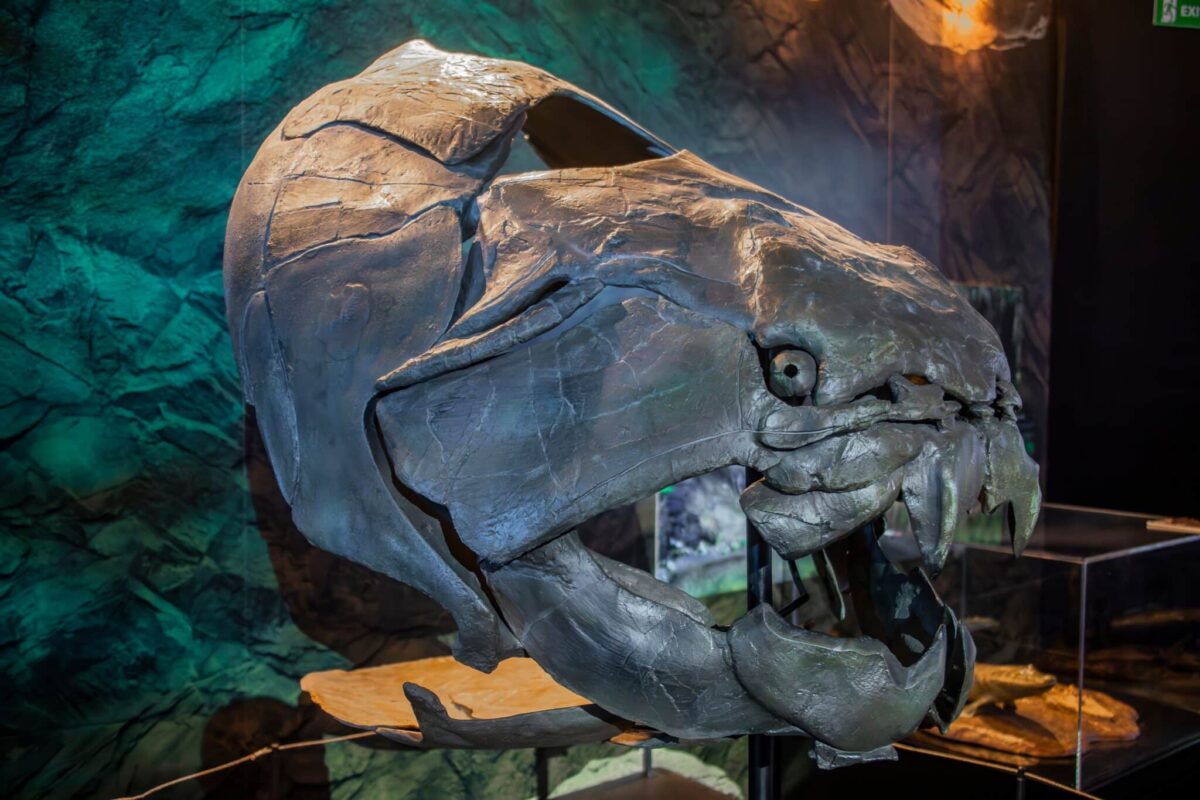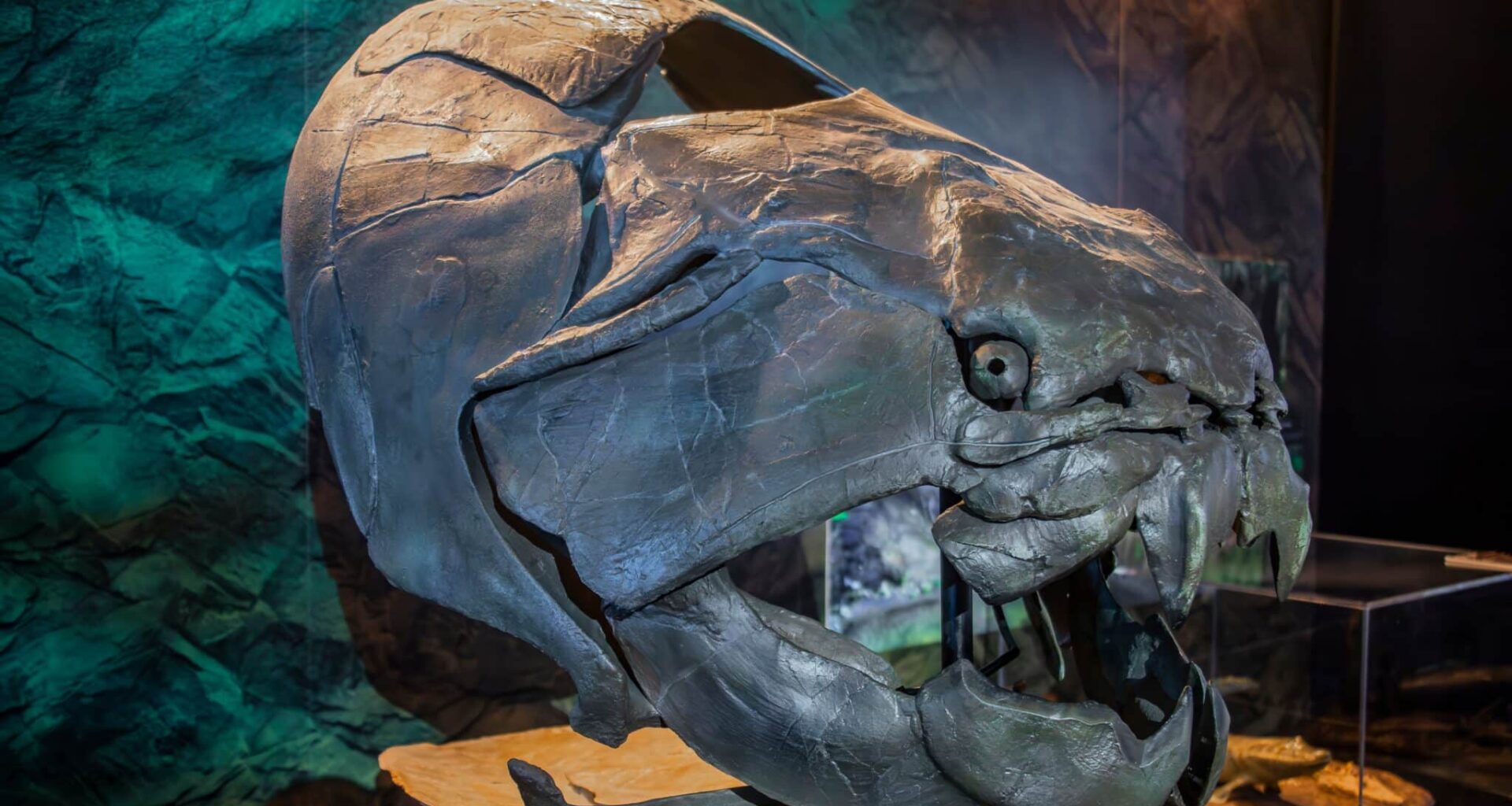
Dunkleosteus was a much more vicious predator than previously believed. (Credit: Danny Ye on Shutterstock)
The aquatic apex predator lived over 300 million years ago in the shallow waters covering present-day Cleveland.
In A Nutshell
Scientists discovered Dunkleosteus had far more cartilage in its skull than previously known, with jaw muscles attaching to soft tissues rather than bone, overturning decades of anatomical assumptions.
The 30-foot armored fish was a ram-feeding predator that chased and dismembered prey with blade-like jaws, not a suction feeder as proposed by 2007-2009 studies based on biomechanical modeling.
Key evidence against suction feeding includes tusk-like fangs, an enormous mouth without sealing structures, a rigid jaw joint, and an open-water habitat where modern predators use ram feeding.
Previous bite force estimates comparing Dunkleosteus to alligators and great white sharks will need complete recalculation based on the corrected muscle attachment locations.
For nearly two decades, paleontologists thought they had Dunkleosteus terrelli figured out. This monstrous, 30-foot fish ruled Late Devonian oceans 360 million years ago. Scientists believed it used suction feeding, vacuuming up prey like a supersized bass. Research published in The Anatomical Record now proves otherwise. It was a ram-feeding predator that chased down meals and sliced them apart with blade-like jaws.
Lead author Russell Engelman and colleagues from Case Western Reserve University, the Cleveland Museum of Natural History, and institutions in Australia, the UK, and Russia spent years re-examining fossils at the Cleveland Museum. What they discovered contradicts years of accepted science. It all came down to anatomy that previous researchers couldn’t see.
Hidden Cartilage Reveals True Jaw Function
The breakthrough came from identifying cartilage structures that rarely fossilize. Dunkleosteus skulls contained far more cartilage than anyone realized. Major jaw muscles attached to these soft tissues rather than to the bony skull roof. Earlier reconstructions from 2007 and 2009 proposed suction feeding based on biomechanical calculations showing rapid jaw expansion. Those models assumed the wrong muscle attachment points.
The jaws themselves tell the real story. Suction-feeding fish have flat patches of small teeth designed to grip prey after it’s drawn into the mouth. Dunkleosteus sported tusk-like fangs (called odontoids) and blade-like cutting edges. These are tools built for chasing and dismembering prey, not generating suction currents. The researchers compare these blade structures to the carnassial teeth of hyenas and big cats. Both slice through tough tissue and break large prey into swallowable pieces.
Size created another problem for the suction-feeding theory. Dunkleosteus had an enormous mouth positioned far back on its head. Larger mouths reduce the pressure difference that powers suction. Modern suction-feeding fish solve this with structures that seal the sides of the mouth. Bony fish use protrusible jaws. Sharks use prominent cartilages. Dunkleosteus had neither. Water would have leaked in during feeding attempts, making suction ineffective.
The team examined specimens ranging from juveniles to massive adults with skull armor up to 9 centimeters thick. A large groove on the bone below the eye revealed the presence of a hefty jaw-closing muscle. This muscle originated on an enlarged cartilage at the front of the skull. The main jaw-closing muscle probably attached to the palatoquadrate (a cartilage forming part of the upper jaw) rather than to the skull roof as previously thought.
Even the lower jaw’s structure argued against suction. The two halves locked together at the front with a flat joint surface that limited flexibility. Some specimens show the sides completely fused. This rigid arrangement works for a biting predator processing large prey. It makes no sense for a suction feeder.
 The muscle (right) and jaw (center) of Dunkleosteus compared with another arthrodire (left). Credit: Russell Engelman, et al. / Case Western Reserve University
The muscle (right) and jaw (center) of Dunkleosteus compared with another arthrodire (left). Credit: Russell Engelman, et al. / Case Western Reserve University
Why Open Water Environments Matter
Where Dunkleosteus lived matters. The Cleveland Shale formation preserves an open water environment. In modern oceans, open water predators hunting mobile prey like fish and squid are ram feeders. They chase prey down. Suction feeding works better in confined spaces or ambush scenarios where prey can’t easily escape.
Bite marks on other large animals from the same time period (including other armored fish and early sharks) show Dunkleosteus attacked big meals. Ram-feeding biters can consume prey larger than their mouth by taking chunks out of it. Suction feeders must swallow prey whole. This limits them to smaller meals that fit through their gape.
The researchers calculated that Dunkleosteus could open its jaws 65 degrees, far wider than the 22 to 45 degrees suggested in previous studies. This wide gape fits the profile of ram feeding and oral processing.
What This Means for Bite Force Calculations
The 2007 study that estimated bite forces rivaling modern alligators and great white sharks based those calculations on muscle attachments that this new research proves were wrong. With muscles attaching to different locations on cartilage structures, bite force estimates will need complete revision.
Dunkleosteus reached lengths up to 9 meters. This made it one of the largest predators of its time. Despite its fame in documentaries and museum displays, scientists have long struggled to understand how it actually lived and hunted. Most fossils are crushed and flattened. Cartilage rarely preserves. Only exceptional specimens from places like Western Australia’s Gogo Formation (where soft tissues sometimes mineralize) have offered glimpses of missing anatomy.
The Cleveland Museum houses five near-complete individuals originally mounted in the 1920s that the team examined. They also compared these with better-preserved fossils from the Gogo Formation and recent discoveries of a new Dunkleosteus species from Russia showing clearer jaw details.
Previous studies suggested this ancient predator “may have utilized an early form of suction feeding” based on biomechanical modeling. But when Engelman and his team looked at the actual preserved anatomy, including rare cartilage elements and muscle attachment sites, the evidence pointed in a completely different direction. The jaws, teeth, and skull structure all indicate a ram-feeding predator that orally processed prey. Understanding how this predator really fed reshapes what scientists know about Late Devonian marine ecosystems and how early jawed vertebrates hunted their prey.
Paper Notes
Limitations
The study acknowledges several limitations inherent to fossil preservation. Most Dunkleosteus fossils are crushed and flattened, requiring significant interpretation to reconstruct original anatomy. Cartilaginous elements, which form major components of the skull and jaw apparatus, rarely preserve in the fossil record, making definitive reconstructions of soft tissue structures challenging. Some anatomical reconstructions remain hypothetical, particularly regarding unpreserved soft tissues like the shape of the adductor fossa (the depression where jaw muscles attach) and the precise configuration of certain cartilages. The function of some anatomical features, such as the lateral consolidated region on the skull roof, remains unclear. The researchers note that while they can confidently argue against suction feeding based on preserved anatomy, complete understanding of feeding mechanics would benefit from preserved branchial (gill) skeleton elements, which are fragmentary and poorly known in Dunkleosteus. Additionally, certain muscle attachment reconstructions involve interpretation based on comparative anatomy with other arthrodires rather than direct preservation.
Funding and Disclosures
Digital models used in this study were created using funds from NSF DBI 2230809 awarded to C. Colleary, A. McGee, H. Majewski, D. Donovan, and the Cleveland Museum of Natural History to create publicly available 3D models. Kate Trinajstic was funded through Australian Research Council grants DP220100825 and DP240102156. The authors declare they have no conflicts of interest.
Publication Details
Engelman, R. K., Carr, R. K., Trinajstic, K., Johanson, Z., & Lebedev, O. A. (2025). Functional anatomy, jaw mechanisms, and feeding behavior of Dunkleosteus terrelli (Placodermi, Arthrodira). The Anatomical Record, 1–62. https://doi.org/10.1002/ar.70075

